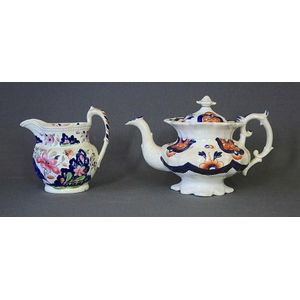19th Century Staffordshire Cow Spill Vase with Repairs
You must be a subscriber, and be logged in to view price and dealer details.
Subscribe Now to view actual auction price for this item
When you subscribe, you have the option of setting the currency in which to display prices to $Au, $US, $NZ or Stg.
- A/f, as Inspected - The letters "A/F" or "as inspected" as part of a description is the cataloguer's shorthand for "all faults" or "as found", meaning the item has some type of damage or deficiency, it is of uncertain date or provenance, and/or that the seller takes no responsibility for the completeness of the item or the accuracy of the description.
- Spill Vase - Popular in Victorian times, a spill vase was a vessel for holding thin slips of wood or spills of paper with which to light a candle or pipe from a fire. For ease of access to the fire, they usually sat on the mantlepiece or had a hole in the back, so they could be hung from a wall. Their use declined with the with the evolution of heating through use of electricity and the use of safety matches in the late 19th century.
- Firing Crack - A firing crack is a crack in a porcelain or stoneware item that occurs whilst the item is in the kiln.They are usually caused by faulty design, where one part is thicker than the surrounding area, and being thicker it cools more slowly, setting up a stress with the surrounding area. Firing cracks are not often seen on modern mass produced porcelain, as the damaged items are discarded during prooduction. However they are seen in earlier items and artisan-produced objects.
- Flatback - As the name indicates, flatback Staffordshire figures are characterized by their undecorated flat backs and are typically designed to be displayed to sit on a narrow mantlepiece. They often made in pairs and depict popular scenes or characters from literature, mythology, or history, and they were prized for their intricate details and bright colours.
These figures were popular in England during the 19th century, and they were widely produced and sold by a number of different Staffordshire based manufacturers.
In the late 1880's to the early 1900s Royal Worcester also manufactured a series of floral decorated jugs which are termed 'flat backs'.
This item has been included into following indexes:
- Staffordshire Potteries (England), item types
Visually similar items

18th century Staffordshire applied group figure

Two various early English porcelain items, including Rockingham type teapot (restored finial and lid); & milk jug inscribed 'David & Susannah Sykes. Hollow Mire. 1834.' H18 cm (teapot)

Royal Worcester blush ivory jug decorated with hand painted flowers and gilding

Spode red stoneware jug, hand painted floral and leaf decoration. Design # 3339 to base. Height 16 cm
